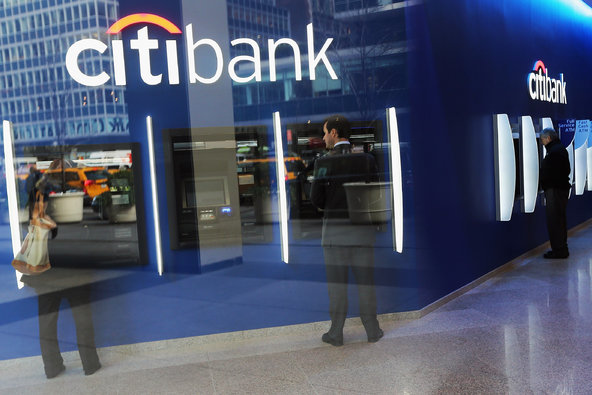 Mark Lennihan/Associated PressMorgan Stanley’s headquarters in New York. The firm posted a 42 percent rise in profit and said it would buy back part of its stock.
Mark Lennihan/Associated PressMorgan Stanley’s headquarters in New York. The firm posted a 42 percent rise in profit and said it would buy back part of its stock.
Morgan Stanley shares rose more than 4 percent on Thursday after the firm announced it planned to buy back a chunk of its own stock.
News that the firm had received approval from the Federal Reserve to repurchase $500 million worth of its stock was good for shareholders, whose stake in the company has been diluted in recent years as the firm issued millions of shares to pay employees. This dilution has weighed on the stock, and it was trading in the teens earlier this year.
The stock rose about 4.4 percent, or $1.16, to close at $27.70, a level it has not hit since 2011. It is the first buyback Morgan Stanley has undertaken since the financial crisis and comes after the firm’s decision to buy the remaining stake of its wealth management business, a move James P. Gorman, the firm’s chairman and chief executive, has heralded as “transformational.”
Related Links
Morgan Stanley received approval from regulators in June to buy the rest of its wealth management division, a joint venture it formed with Citigroup during the crisis. Since then, the firm has been working to diversify its earnings, moving away from riskier businesses like trading and into wealth management, which offers steady, albeit lower returns. Its ability to purchase all of that division gave it full control of the operation and the full share of the profits.
Mr. Gorman told analysts that the firm was careful to have the wealth management purchase in order — and paid for — before it started spending money on stock buybacks.
The other good news for shareholders was the firm’s second-quarter earnings, which came in slightly ahead of analysts’ expectations.
The firm reported that second-quarter profit applicable to Morgan Stanley’s common shareholders rose 42 percent, to $802 million, or 41 cents a share, compared with $564 million, or 29 cents a share, in the period a year earlier. Overall net income was $980 million, compared with $591 million in the period a year earlier.
The results, however, were affected by two big charges, one related to Morgan Stanley’s credit spreads and the other to its recent purchase of the remaining stake of the wealth management business. Stripping out those charges, the firm had a profit of $872 million, or 45 cents a share. That beat the estimates of analysts polled by Thomson Reuters, which had projected a profit of 43 cents a share.
Morgan Stanley’s revenue, excluding those charges, rose to $8.3 billion in the second quarter from $6.6 billion in the period a year earlier.
The results were driven by decent performances in most of its business units, notably wealth management and equity and debt trading. Morgan Stanley is coming off what was a weak second quarter of 2012 and is also enjoying what seems to be a better operating environment for all banks.
Morgan Stanley is the last big financial institution to report second-quarter earnings, and results have been generally strong as lenders seem to be benefiting from a pickup in the American economy. Goldman Sachs, for instance, reported that its net income doubled, beating analysts’ expectations handily.
At Morgan Stanley, wealth management, which is led by Gregory J. Fleming, was a big focus for analysts on the quarterly conference call.
That unit, with 16,321 financial advisers, posted net revenue of $3.5 billion, up more than 10 percent. Its pretax profit margin, a widely watched figure on Wall Street, came in at 18.5 percent. That margin, which previously had been around 17 percent, was higher than the firm’s expectations.
Institutional securities, which houses Morgan Stanley’s banking and trading operations, posted net revenue, excluding the debt charge, of about $4.2 billion, up about 40 percent from a year earlier.
The firm experienced a solid increase in revenue from various segments in this department, including debt and equity underwriting, investment banking, and currency and commodities trading.
The fixed-income sales and trading unit reported that adjusted revenue rose to $1.2 billion from $771 million in the period a year earlier. This year’s performance was slightly below what analysts were hoping for.
In the second quarter, there was a sudden and sharp rise in interest rates after the Federal Reserve indicated it might wind down its bond purchase program, which has helped the economy recover from the financial crisis.
Ruth Porat, the bank’s chief financial officer, told analysts that the firm reduced the risk it was taking trading interest rate products.
While the bank’s second-quarter results were a marked improvement over those in the period a year earlier, the firm is still producing a return on equity, excluding the two charges, of just 5.6 percent. This is up from 2.1 percent in the period a year earlier but still well below what it costs the bank to simply cover its debt expenses and other capital costs. To do that, it needs to achieve a return on equity, an important measure of profitability, of closer to 10 percent.
Article source: http://dealbook.nytimes.com/2013/07/18/morgan-stanley-profit-rises-42-percent/?partner=rss&emc=rss
